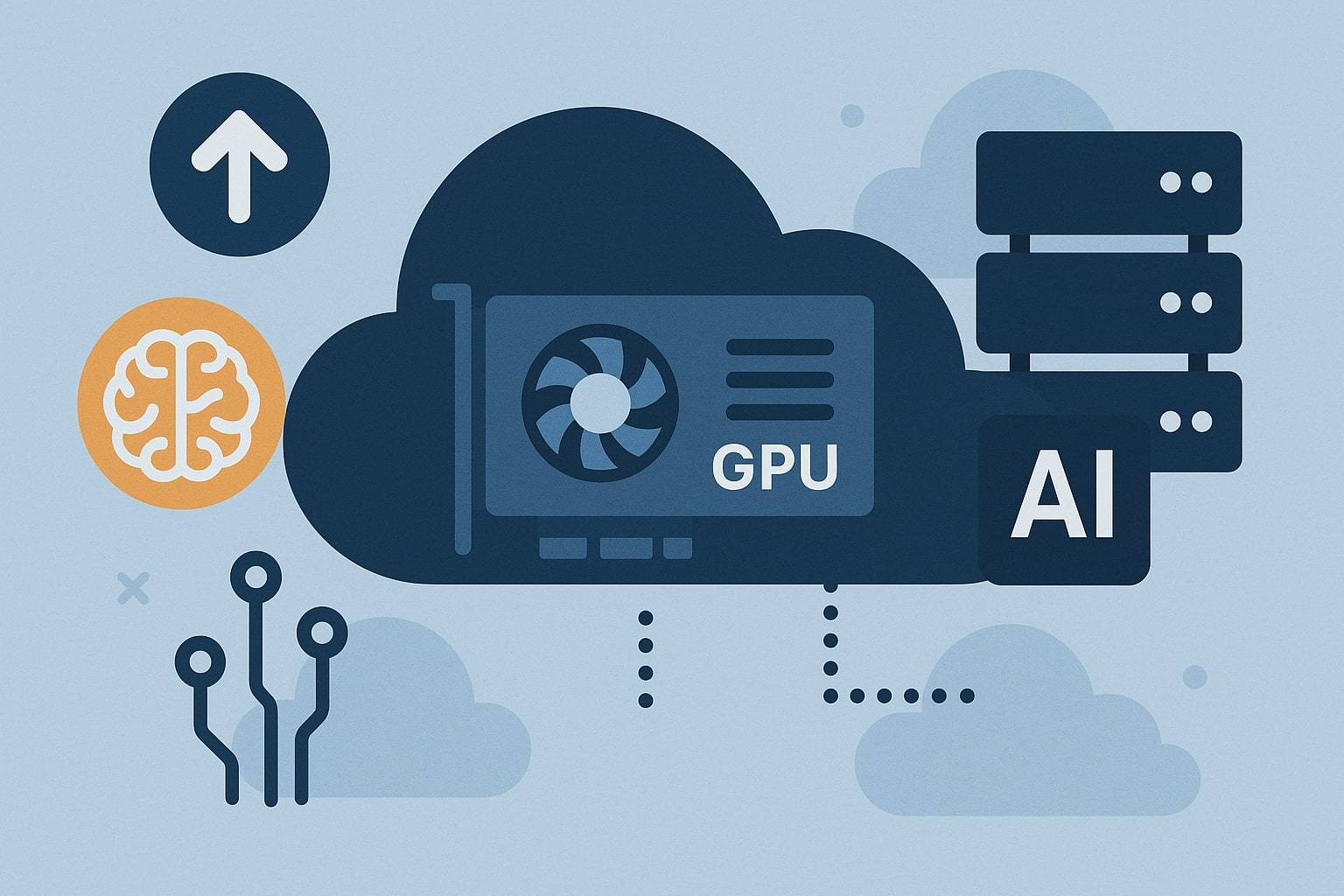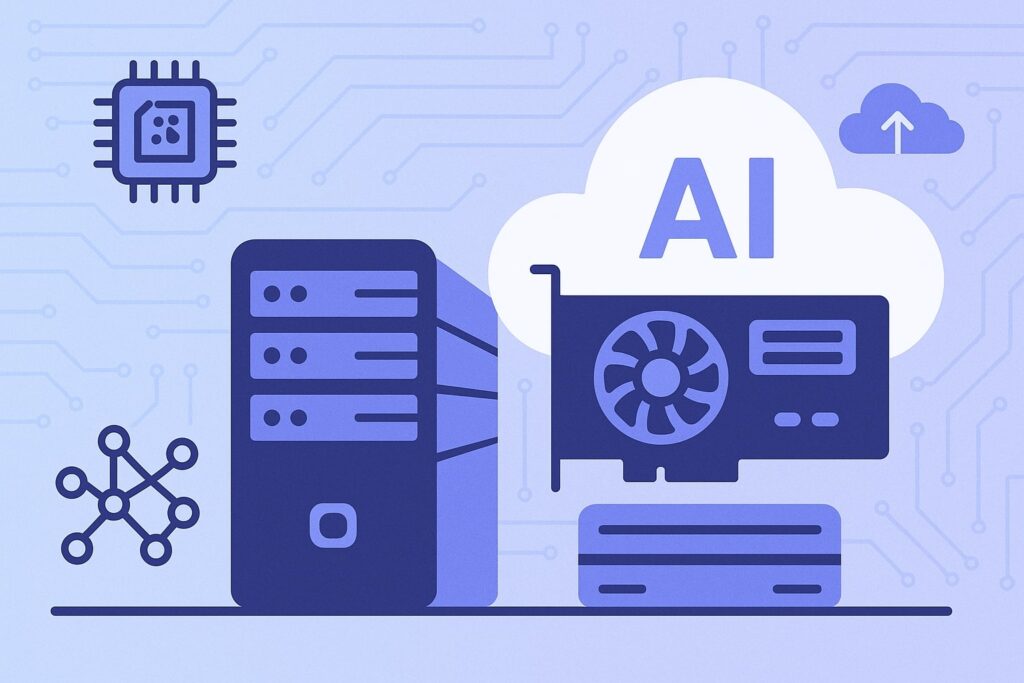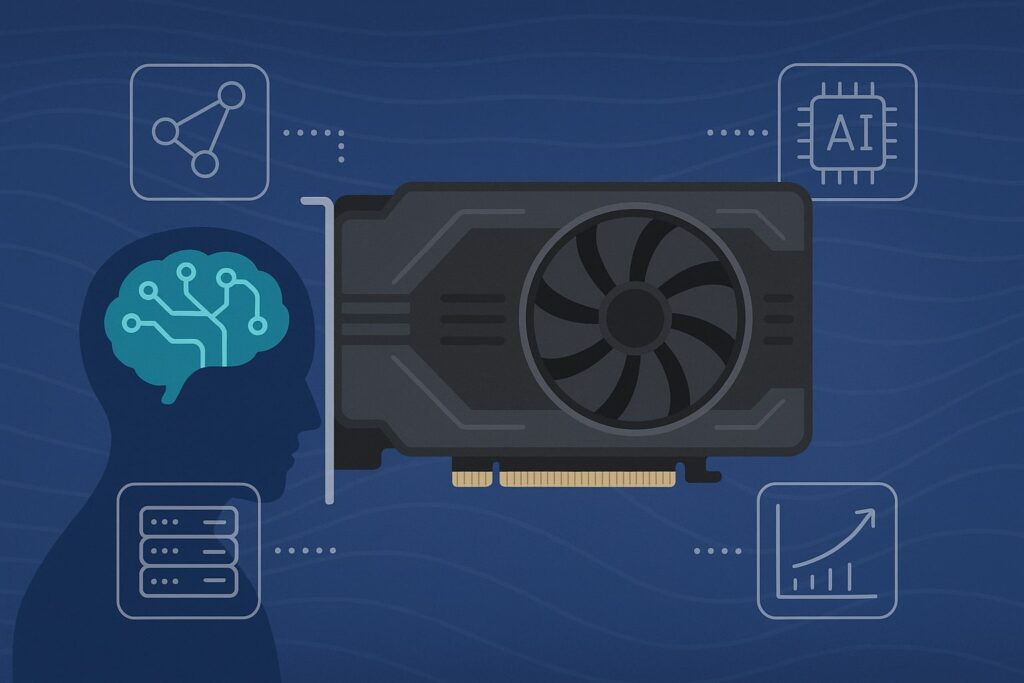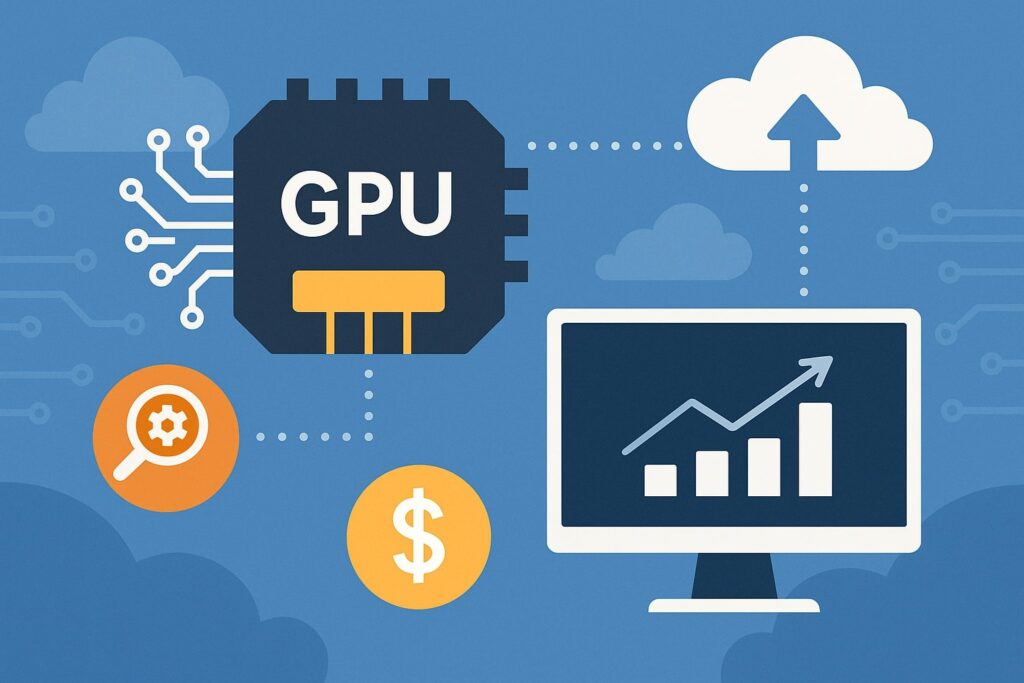
By hostmyai September 29, 2025
Artificial intelligence (AI) is pushing the limits of traditional computing, demanding more speed, scalability, and flexibility than ever before. At the heart of this revolution are GPU-powered cloud instances—virtual machines equipped with graphics processing units (GPUs) designed to accelerate complex computations.
Unlike standard CPUs, GPUs excel at handling massive parallel workloads, making them the backbone of modern AI, deep learning, and high-performance computing (HPC).
In this comprehensive guide, we will explore the concept of GPU-powered cloud instances, why they matter for AI, their architecture, benefits, real-world applications, challenges, providers, and how businesses can adopt them effectively.
Understanding GPU-Powered Cloud Instances for AI

GPU-powered cloud instances are virtual computing environments hosted by cloud providers that give users access to powerful GPUs without requiring them to purchase and maintain the hardware themselves.
Traditionally, GPUs were primarily associated with rendering video games and 3D graphics, but over time, researchers discovered their potential in processing parallel workloads such as neural network training.
AI workloads—especially deep learning models—require computations across millions or billions of parameters simultaneously. CPUs, though powerful, are optimized for sequential task execution and often struggle to scale for such use cases.
GPUs, on the other hand, contain thousands of cores capable of executing multiple tasks in parallel, significantly speeding up training times for AI models.
For example, training a natural language processing (NLP) model on CPUs could take weeks, while GPUs can reduce that time to days or even hours. When these GPUs are hosted in the cloud, businesses gain the flexibility to scale resources up or down based on workload requirements.
This on-demand access democratizes AI innovation, enabling startups, research institutions, and enterprises to tap into cutting-edge computational power without massive upfront investments.
Furthermore, GPU cloud instances are not limited to training models. They also play a vital role in inference tasks (deploying AI models to make real-time predictions), computer vision, scientific simulations, and advanced data analytics. This versatility makes them a cornerstone of the AI ecosystem.
The Role of GPUs in AI Workloads

The rise of AI would not have been possible without the evolution of GPUs into highly specialized processors for data-intensive applications. To understand their role, it’s important to break down the nature of AI workloads.
Training a deep learning model involves repeated iterations of forward and backward propagation, requiring linear algebra operations such as matrix multiplication and tensor calculations.
CPUs, with a handful of powerful cores, can handle these tasks but at a slower pace. GPUs, however, shine because they consist of thousands of smaller, efficient cores optimized for parallel processing.
Take convolutional neural networks (CNNs), which are widely used in computer vision. These networks rely on repeated convolution operations applied to image data. GPUs accelerate this process by distributing computations across their cores.
Similarly, transformers—the backbone of modern NLP models like GPT—require massive amounts of matrix multiplication, which GPUs handle with ease.
In addition, GPUs leverage high memory bandwidth, which is crucial when transferring large datasets between memory and processors.
Paired with CUDA (NVIDIA’s parallel computing platform), libraries like cuDNN, and deep learning frameworks such as TensorFlow or PyTorch, GPUs create a highly optimized environment for AI research and deployment.
Cloud providers take this further by offering specialized GPU instances optimized for AI. These instances often feature NVIDIA A100, H100, or V100 GPUs, each designed for large-scale model training and inference.
With such capabilities, GPUs have become indispensable in powering the most advanced AI applications, from autonomous vehicles to drug discovery.
Benefits of GPU-Powered Cloud Instances

Adopting GPU-powered cloud instances provides organizations with a wide range of advantages that go beyond performance. These benefits make them a practical choice for businesses seeking to accelerate AI innovation.
- Unmatched Performance: GPU instances drastically reduce the time required to train AI models. For example, training a large-scale image recognition model could drop from weeks to just a few days. This performance boost not only accelerates innovation but also lowers the cost of experiments and iterations.
- Scalability and Flexibility: Cloud infrastructure allows businesses to scale GPU usage based on demand. Startups may begin with a few instances for experimentation, while enterprises can scale to hundreds or thousands of GPUs for production-level workloads.
- Cost Efficiency: Purchasing and maintaining GPU servers is prohibitively expensive, often costing tens of thousands of dollars per unit. Cloud instances eliminate this barrier by offering pay-as-you-go pricing, allowing organizations to pay only for what they use.
- Accessibility for All: Researchers, developers, and businesses of any size can access top-tier hardware without heavy capital expenditure. This accessibility fuels innovation across industries, from healthcare to finance to education.
- Integration with Ecosystems: Leading cloud providers offer pre-configured AI environments with frameworks like TensorFlow, PyTorch, and JAX. This saves setup time and ensures seamless integration with storage, data pipelines, and deployment services.
- Global Reach: With cloud data centers worldwide, organizations can deploy GPU-powered AI workloads close to their end-users, reducing latency and ensuring real-time responsiveness for applications like chatbots or recommendation engines.
- Security and Reliability: Cloud providers invest heavily in security, compliance, and uptime guarantees. This ensures that AI workloads run in secure, resilient environments with minimal downtime.
In short, GPU cloud instances provide the performance, cost savings, and agility that AI-driven businesses need to remain competitive in a fast-moving landscape.
Use Cases of GPU-Powered Cloud Instances in AI
The versatility of GPU-powered cloud instances has unlocked innovation across multiple industries. Below are some prominent use cases:
- Natural Language Processing (NLP): From chatbots to translation systems, training transformer-based models like GPT and BERT relies heavily on GPUs.
- Computer Vision: Applications like medical imaging, facial recognition, and autonomous driving all require large-scale image and video analysis.
- Generative AI: Text-to-image models (e.g., Stable Diffusion, DALL-E) and generative audio/video rely on GPUs to create realistic outputs.
- Scientific Research: Researchers use GPUs for simulations in physics, chemistry, and genomics, significantly speeding up discoveries.
- Financial Services: Fraud detection models and high-frequency trading strategies benefit from GPU acceleration.
- Gaming & AR/VR: Cloud-based rendering and AI-driven personalization use GPUs for immersive experiences.
Each of these examples underscores how GPUs act as enablers of innovation, turning theoretical AI models into practical, real-world solutions.
Challenges of Using GPU-Powered Cloud Instances
Despite their many advantages, GPU cloud instances come with challenges that organizations must navigate:
- Cost Management: While cloud eliminates upfront hardware investments, ongoing usage costs can escalate quickly if not managed.
- Complexity of Scaling: Running large-scale GPU clusters for distributed training requires expertise in resource allocation and orchestration.
- Vendor Lock-In: Relying heavily on one cloud provider’s ecosystem can limit flexibility and portability of AI workloads.
- Latency Issues: For real-time inference, latency can be a concern if data centers are geographically distant from end-users.
- Skill Requirements: Teams must possess expertise in GPU programming, frameworks, and optimization techniques to fully leverage GPU power.
Mitigating these challenges involves careful planning, cost monitoring, adopting multi-cloud strategies, and investing in upskilling teams.
Leading Providers of GPU-Powered Cloud Instances
Several major cloud providers lead the market in offering GPU-powered instances tailored for AI workloads:
- Amazon Web Services (AWS): Offers GPU instances like P4 and P5 powered by NVIDIA A100/H100. Integrated with SageMaker for ML workflows.
- Microsoft Azure: Provides NC, ND, and NV series instances optimized for AI training, inference, and visualization.
- Google Cloud Platform (GCP): Offers NVIDIA GPUs including A100 and H100, with Tensor Processing Units (TPUs) as an alternative.
- IBM Cloud: Specializes in GPU instances for HPC and AI research.
- Smaller Players: Paperspace, Lambda Labs, and CoreWeave cater specifically to AI startups with GPU-focused offerings.
Each provider differentiates itself through ecosystem integrations, pricing models, and specialized hardware availability.
Best Practices for Adopting GPU Cloud Instances
To maximize the value of GPU-powered cloud instances, organizations should follow best practices:
- Evaluate Workload Needs: Not all workloads require GPUs. Assess whether CPU, TPU, or FPGA might be more cost-effective.
- Use Spot Instances: Cloud providers offer discounted spot instances for non-critical workloads, reducing costs significantly.
- Optimize Model Architectures: Efficient model designs, pruning, and quantization can minimize GPU requirements.
- Leverage Auto-Scaling: Automating scaling ensures resources match workload demand dynamically.
- Monitor Usage: Tools like AWS Cost Explorer and GCP Billing dashboards help track and control costs.
- Experiment with Multi-Cloud: Diversifying across providers prevents lock-in and improves resilience.
Following these strategies ensures businesses harness GPU power without overspending or overcomplicating deployments.
FAQs
Q1: Why are GPUs better than CPUs for AI workloads?
Answer: GPUs are designed with thousands of cores optimized for parallel computations, making them far superior for tasks like matrix multiplication and tensor operations central to AI. CPUs, in contrast, are optimized for sequential execution and general-purpose tasks.
While CPUs can run AI workloads, they are significantly slower for large-scale training. For example, training a deep learning model on a CPU could take weeks, while GPUs reduce the time to days or even hours.
This performance difference directly impacts innovation speed, cost efficiency, and feasibility of deploying advanced AI applications.
Additionally, GPUs offer higher memory bandwidth, which is crucial for moving large datasets during training. Coupled with frameworks like CUDA and cuDNN, GPUs are tightly integrated with modern AI software ecosystems, making them the clear choice for most machine learning practitioners.
Q2: Are GPU-powered cloud instances expensive?
Answer: The cost of GPU-powered cloud instances depends on the type of GPU, the provider, and the pricing model. High-end GPUs like NVIDIA A100 or H100 can cost several dollars per hour on major cloud platforms.
While this may seem expensive, the performance benefits often outweigh the costs. By reducing training time, GPUs lower the total compute hours required, making them cost-effective in practice.
Businesses can also manage expenses by using spot instances, auto-scaling, and right-sizing GPU resources for their workloads.
For startups and researchers, smaller providers like Paperspace or Lambda Labs offer more affordable GPU access tailored to AI experimentation. Ultimately, while GPU instances can be costly, strategic planning and optimization ensure their value far exceeds their price.
Q3: Can small businesses benefit from GPU cloud instances?
Answer: Yes, GPU-powered cloud instances are not just for tech giants. Small businesses can leverage them to build AI-powered solutions like chatbots, recommendation engines, and fraud detection systems without investing in expensive hardware. Cloud platforms democratize access, allowing smaller organizations to experiment and deploy at their own pace.
Moreover, with pay-as-you-go pricing, small businesses can start with minimal resources and scale as their AI adoption grows.
Many providers also offer credits, discounts, or startup-focused programs to lower barriers to entry. This levels the playing field, enabling smaller players to compete with larger organizations in AI innovation.
Q4: How do GPU instances compare to TPUs and FPGAs?
Answer: While GPUs dominate AI workloads, they are not the only option. TPUs (Tensor Processing Units), developed by Google, are specialized hardware designed specifically for AI and machine learning.
They excel at matrix-heavy computations but are primarily available on Google Cloud. FPGAs (Field-Programmable Gate Arrays) provide flexibility by allowing custom hardware configurations, making them ideal for specialized use cases.
GPUs remain the most widely adopted because of their versatility, compatibility with multiple frameworks, and availability across cloud providers.
However, organizations should evaluate workload requirements to choose the right hardware. For example, TPUs may be better for large-scale training on TensorFlow, while FPGAs may shine in edge computing scenarios.
Conclusion
GPU-powered cloud instances have become the cornerstone of modern AI, enabling rapid innovation across industries by delivering performance, scalability, and cost efficiency.
From training massive language models to powering real-time inference, GPUs provide the computational backbone required for today’s AI-driven world.
By leveraging cloud infrastructure, organizations of all sizes—from startups to enterprises—gain access to world-class GPU hardware without heavy upfront investment. While challenges like cost management and vendor lock-in exist, strategic adoption and best practices can help maximize value.
As AI continues to evolve, GPU-powered cloud instances will remain at the forefront of innovation, empowering businesses, researchers, and developers to push the boundaries of what’s possible in artificial intelligence.